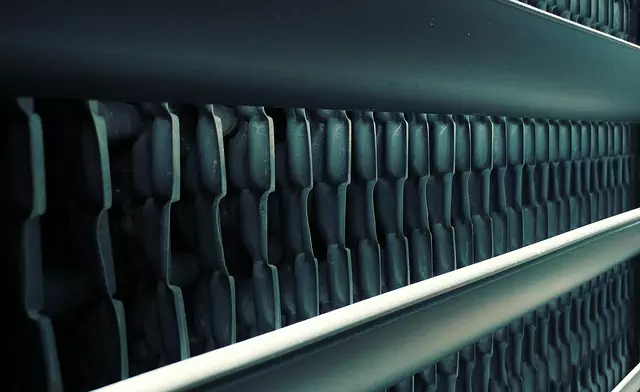Industrial ventilation systems play a critical role in maintaining healthy and safe workspaces by controlling and removing pollutants, fumes, dust, and airborne contaminants. These systems are tailored to specific workplace needs, with regular maintenance and adherence to ventilation safety standards being essential for optimal performance. By integrating components like fans, ductwork, filters, and control mechanisms, effective ventilation designs ensure clean air quality, protect worker health, and comply with regulations. High-risk industries, such as pharmaceuticals, chemical manufacturing, and food processing, require stringent ventilation safety standards and unique strategies to manage hazardous substances. The future of commercial ventilation systems focuses on smart, energy-efficient solutions that prioritize workplace air quality management and enhanced safety through IoT technology, green technologies, and advanced air purification techniques.
Ventilation system design is a critical component of workplace air quality management, especially in industrial settings where proper airflow and contaminant control are essential for worker health and safety. This comprehensive guide delves into the intricacies of industrial ventilation systems, exploring key components, safety standards, optimization strategies, and best practices through case studies. From understanding the fundamentals to embracing future trends, this article equips professionals with insights to enhance ventilation design and uphold stringent ventilation safety standards.
- Understanding Industrial Ventilation Systems: A Foundation for Air Quality Management
- Key Components of Effective Workplace Ventilation Design
- Ventilation Safety Standards: Ensuring a Healthy and Compliant Environment
- Strategies for Optimizing Airflow and Removing Contaminants in Industrial Settings
- Case Studies: Best Practices in High-Risk Industries for Ventilation System Design
- Future Trends and Innovations in Commercial Ventilation Systems for Improved Workplace Safety
Understanding Industrial Ventilation Systems: A Foundation for Air Quality Management
Industrial ventilation systems play a crucial role in workplace air quality management, ensuring a safe and healthy environment for employees. These systems are designed to control and remove pollutants, fumes, dust, and other airborne contaminants that can negatively impact workers’ health and productivity. By understanding the fundamentals of industrial ventilation, designers and managers can implement effective strategies to maintain optimal air quality.
Proper ventilation safety standards dictate the need for adequate airflow, proper distribution, and efficient exhaust mechanisms. These systems must be tailored to the specific needs of each workplace, considering factors like the type of industry, potential hazards, and the number of employees. Regular maintenance and inspections are vital to guarantee these systems function optimally, thereby safeguarding worker health and adhering to relevant regulations.
Key Components of Effective Workplace Ventilation Design
Effective workplace ventilation design involves integrating key components to ensure optimal air quality and worker safety. Industrial ventilation systems play a crucial role in maintaining healthy indoor environments by removing contaminated or stale air and introducing fresh outdoor air. These systems include fans, ductwork, filters, and control mechanisms that work in harmony to regulate airflow and minimize airborne contaminants.
Proper workplace air quality management demands consideration of various factors such as the source and type of pollutants, occupant needs, and environmental conditions. Compliance with ventilation safety standards is paramount to safeguard employees from hazardous substances. By meticulously designing and implementing these systems, organizations can foster a productive and safe work environment that enhances employee well-being and reduces health risks associated with poor air quality.
Ventilation Safety Standards: Ensuring a Healthy and Compliant Environment
Maintaining a safe and healthy working environment is paramount, especially in industries where proper ventilation is crucial for employee well-being and operational efficiency. Industrial ventilation systems play a vital role in ensuring workplace air quality management by removing hazardous fumes, dust, and other pollutants from the air. Adherence to ventilation safety standards is essential to safeguard workers from respiratory issues and other health complications associated with poor indoor air quality.
Compliance with these standards involves designing and implementing systems that meet specific requirements for airflow, filtration, and exhaust. Regular inspections, maintenance, and employee training are integral components of maintaining a compliant environment. By prioritizing ventilation safety standards, businesses can foster a productive atmosphere while mitigating potential risks, contributing to the overall success and sustainability of operations.
Strategies for Optimizing Airflow and Removing Contaminants in Industrial Settings
Optimizing airflow and removing contaminants in industrial settings is a multifaceted task that requires a holistic approach. Industrial ventilation systems play a crucial role in ensuring workplace air quality management by facilitating the movement of clean air and evacuating pollutants, thus enhancing safety and employee comfort. To achieve this, designers must employ strategic techniques such as proper zoning, which involves dividing large spaces into smaller zones to control airflow direction and intensity more precisely. This is especially important in areas with varying contamination levels.
Additionally, the implementation of high-efficiency particulate air (HEPA) filters is vital for removing fine particles, including dust, smoke, and hazardous aerosols. These advanced filtration systems capture at least 99.97% of particles as small as 0.3 microns, significantly improving indoor air quality. Regular maintenance, including filter replacement and system inspections, according to ventilation safety standards, is essential to guarantee the continuous effectiveness of these strategies.
Case Studies: Best Practices in High-Risk Industries for Ventilation System Design
In the realm of industrial ventilation systems, best practices for design vary greatly based on sector and specific risks. High-risk industries like pharmaceuticals, chemical manufacturing, and food processing require meticulous ventilation safety standards to mitigate hazardous dusts, fumes, and gases. Case studies from these sectors highlight effective strategies for workplace air quality management. For instance, pharmaceutical companies often implement highly controlled environments using HEPA filters and laminar flow hoods to prevent contamination. Chemical plants utilize specialized extraction systems tailored to specific chemicals, ensuring safe removal of volatile organic compounds (VOCs).
These industrial ventilation systems are designed based on comprehensive risk assessments and adherence to stringent local regulations. Regular maintenance and inspections are integral to their long-term efficiency and safety. By learning from such case studies, other industries can adapt best practices for their own ventilation system design, enhancing workplace air quality management while adhering to crucial ventilation safety standards.
Future Trends and Innovations in Commercial Ventilation Systems for Improved Workplace Safety
The future of commercial ventilation systems is poised for significant advancements, driven by a growing emphasis on workplace air quality management and enhanced safety standards. Emerging trends indicate a shift towards smarter, more efficient industrial ventilation solutions that integrate IoT (Internet of Things) technologies. These innovations enable real-time monitoring of air quality parameters like CO2 levels, temperature, and humidity, allowing for data-driven adjustments to maintain optimal conditions. Such systems can adapt to changing occupancy patterns and environmental factors, ensuring consistent ventilation safety standards across diverse work environments.
Additionally, sustainability is becoming a key focus in ventilation system design. Green technologies, such as energy-efficient motors, heat recovery systems, and the use of renewable energy sources, are being incorporated into industrial ventilation systems. These innovations not only contribute to reducing carbon footprints but also lower operational costs for businesses. As workplace safety standards continue to evolve, future commercial ventilation systems will likely incorporate advanced air purification techniques, like high-efficiency particulate air (HEPA) filters, to mitigate the risk of airborne disease transmission, further enhancing overall workplace safety.


